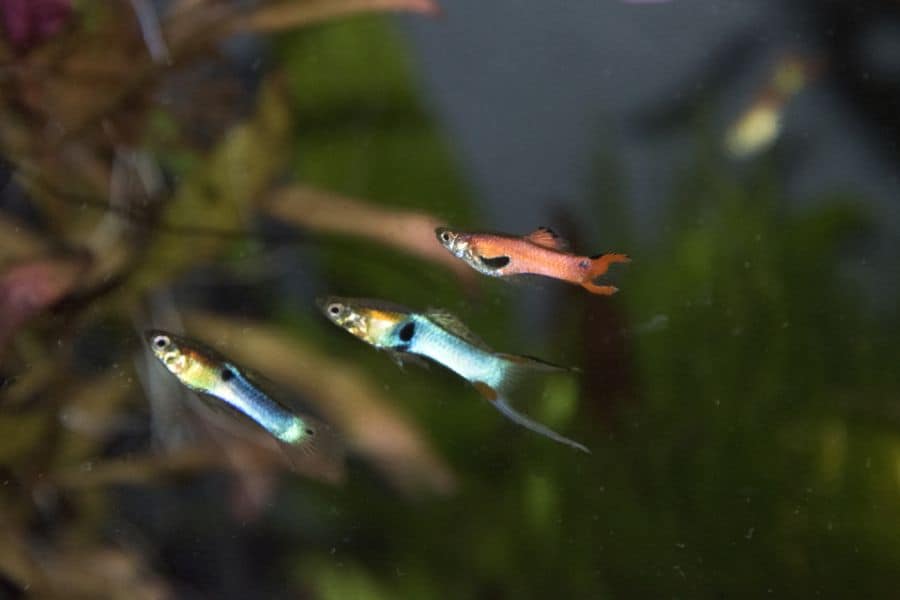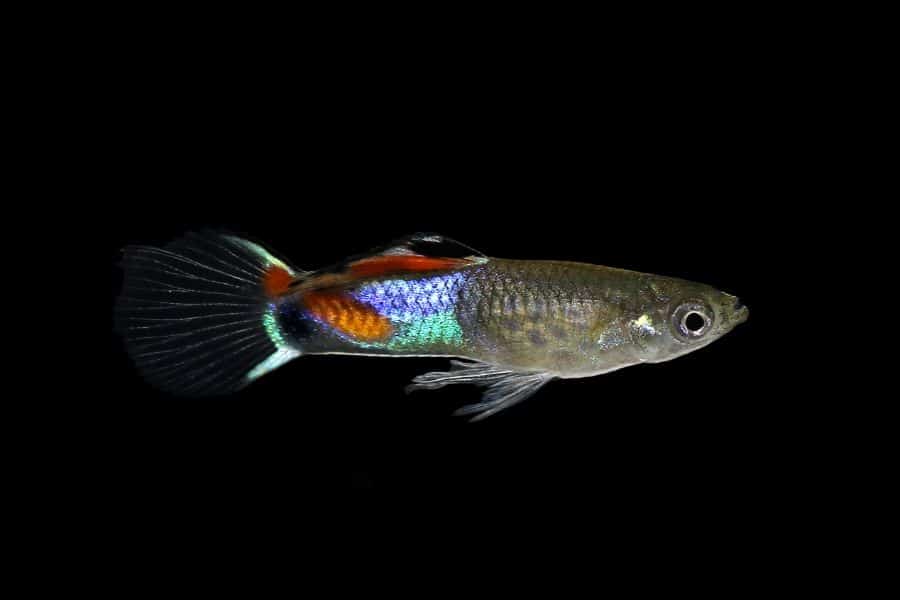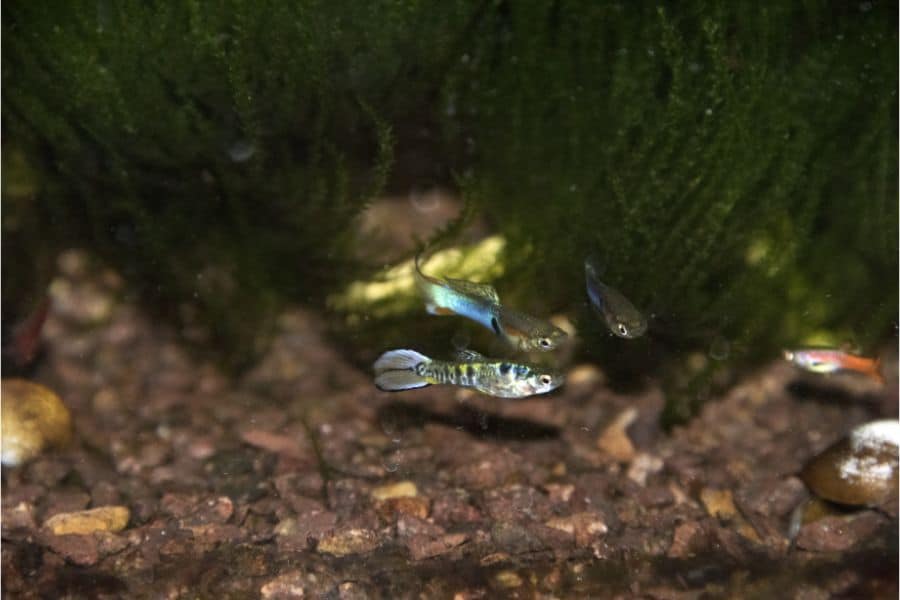Known for their vibrant look, exciting personalities, and ease of care, Endler’s Livebearers are small tropical fish that have cemented their reputation as a safe choice when creating a new community aquarium.
Both beginner and expert fishkeepers alike love their energetic presence and unique aesthetic in all tank setups.
That said, as resilient as they are, aspiring fishkeepers still need to know how to care for this species properly and responsibly.
In this article, we’ll discuss everything you need to know about Endler’s Livebearers – from their origins to their breeding habits and much more!
Endler’s Livebearer Basics
| Physical Traits | Ideal Tank Parameters | ||
| Scientific Name | Poecilia wingei | Water Type | Freshwater |
| Common Names | Endler’s Livebearer, Endler’s Guppy, Endlers | Temperature Range | 75 to 86°F or 24 to 30°C |
| Family | Poeciliidae | Water Hardness | 5-15 dkH |
| Size | 1.5 to 1.8 inches | pH Range | 7.0 to 8.5 |
| Care Level | Easy | Water Flow | Low to moderate |
| Activity Level | Active | Ideal Minimum Tank | 10 gallons |
| Diet | Omnivorous | Minimum Number | 3 (1 male, 2 females) |
| Lifespan | 1 – 3 years | Planted Tank | Ideal for planted tank |
| Behavior | Breeding | ||
| Temperament | Peaceful | Difficulty to Breed | Very easy |
| Compatibility | Community tanks | Spawning Type | Livebearers |
| Group Behavior | Best kept in groups of several females to one male | Sexing | Males are smaller but more colorful, while females are larger |
Here are three fast facts about Endler’s Livebearers!
- They give birth to live young: True to their name, Endler’s Livebearers give birth to actual fry.
- They’re often mistaken as Guppies: Although they share plenty of similarities, Endlers are a different species from Guppies.
- They can crossbreed: Since they’re closely related, Guppies and Endlers can breed with each other. The offspring is called Endler’s Guppy.
- They’re notorious for breeding: Female Endlers can give birth every 24 days. That’s why most aquarists choose to keep single-sex tanks.
- They weren’t named after the man who discovered them: In fact, they were forgotten at first, only to be popularized after they were rediscovered by Dr. John Endler.
Endler’s Livebearer Origins
Scientifically known as Poecilla wingei, this livebearing species come from the freshwater streams of the lagoons of Venezuela.
The lagoon is named Laguna de Patos, located in the Campoma region, below the Paría Peninsula in Venezuela. Although typically isolated from other bodies of water aside from its tributaries, the Laguna de Patos floods during the rainy seasons and interconnects with other bodies of water.
Sadly, it’s quite polluted, as well as its tributary canals and rivers. The water would often be full of algal bloom and have a layer of detritus on the bottom.
This is where Endler’s Livebearers were first found. These hardy little fish can navigate changing floodplains and brackish waters with little to minimal cover in the form of hardy plants, tree branches, and other structures.
Interestingly, their common name, Endler’s Livebearers, is named after Dr. John Endler, an American biologist who extensively studied and popularized these fish in the aquarium hobby.
Despite being the fish’s namesake, John Endler was not the first to discover the fish. That honor belongs to Franklin F. Bond, who first discovered the species in 1937. However, it was Dr. Endler, in his rediscovery and subsequent re-description of the species, that popularized the fish in the aquarium trade.
These fish are cherished today for their distinct patterns, vibrant colors, playful nature, and genetic diversity. Endler’s Livebearers are easily a favorite choice among enthusiasts and breeders.
Types of Endler’s Livebearers
True to their name, Endler’s Livebearers breed a whole lot. This makes them ideal for creating beautiful specimens with specific colors and patterns.
To help breeders maintain a high-quality stock, three different classification systems for Endler’s Livebearer genetic strains were developed: N, K, and P.
- Class N: This strain refers to pure-blooded with official certifications and documents that trace their lineage back to pure stock out of their original locations. This is also important to keep track of since their native population is dwindling.
- Class K: This genetic strain includes Endlers that resulted from crossbreeding with guppies and other kinds of livebearers. It typically comes from an Endler’s breeder who has mass-produced this species. It’s also the most common strain to find for sale.
- Class P: Class P fish are simply Endler’s Livebearers that don’t have documents testifying their origins. These fishes might look pure-blooded–and often, it’s difficult to tell them apart–but no one can say for sure without the right documents.
Endlers are slowly gaining popularity in the hobby, although they’re still not as common as other small fishes. They regularly retail at least $10 for one individual, but this can vary wildly depending on their strain.
Some Class N strains can be sold anywhere from $30 to $80, depending on factors like size, colors, and patterns.
Endler’s Livebearer Appearance
It’s no secret that Endler’s Livebearers look very similar to Guppies. For a time, they were even thought to be just another type of guppy. Still, they do have some characteristics that make them distinct.
- Endler’s Livebearers have a compact, streamlined, and slightly laterally compressed body shape that gives them a sleek look. They’re reminiscent of other livebearers like the fancy guppy and platies.
- Prized for their unique coloration, Ember’s Livebearers display vibrant orange, red, yellow, and more hues, depending on their strain.
- Ember’s Livebearers often have a distinctive dark stripe or patch on their body. Their contrasting patterns add a touch of wildness and uniqueness to their appearance.
- Ember’s Livebearers have well-developed dorsal and anal fins extending gracefully along their body.
Female vs. Male Endler’s Livebearer
Breeding is one of the highlights of the fish-keeping hobby, and breeding this particular species is particularly exciting.
Before you can breed, though, you first need to identify the males and females of the species correctly.
- Male Endler’s Livebearers are generally smaller than the females.
- Males boast more intense, more vibrant colors, while females exhibit a subtler tone.
- Male Endlers have elongated dorsal fins and vibrant caudal fins, and they also have a unique pointy anal fin used for breeding called the gonopodium. Females, on the other hand, have distinctly round anal fins.
- Body Shape. Females possess a plumper body shape compared to males, with a rounder abdomen necessary for carrying and giving birth to live fry.
- Males are typically more active and energetic than females. They also do a lot of displays around the females, especially during their mating seasons. On the other hand, females are more calm and relaxed.
Endler’s Livebearer Size
Adult Endlers can reach an average size of 1 to 1.8 inches in length.
The differences between individuals can be rather pronounced, especially among males and females. Males reach a maximum size of 1 to 1.2 inches, while females can grow a little larger, to about 1.8 inches.
It’s essential to consider the size of your fish, especially if you’re putting them in a community aquarium. Endlers, especially, are smaller than average, which might lead to them being bullied in a community aquarium with many other larger fishes.
Endler’s Livebearer Lifespan
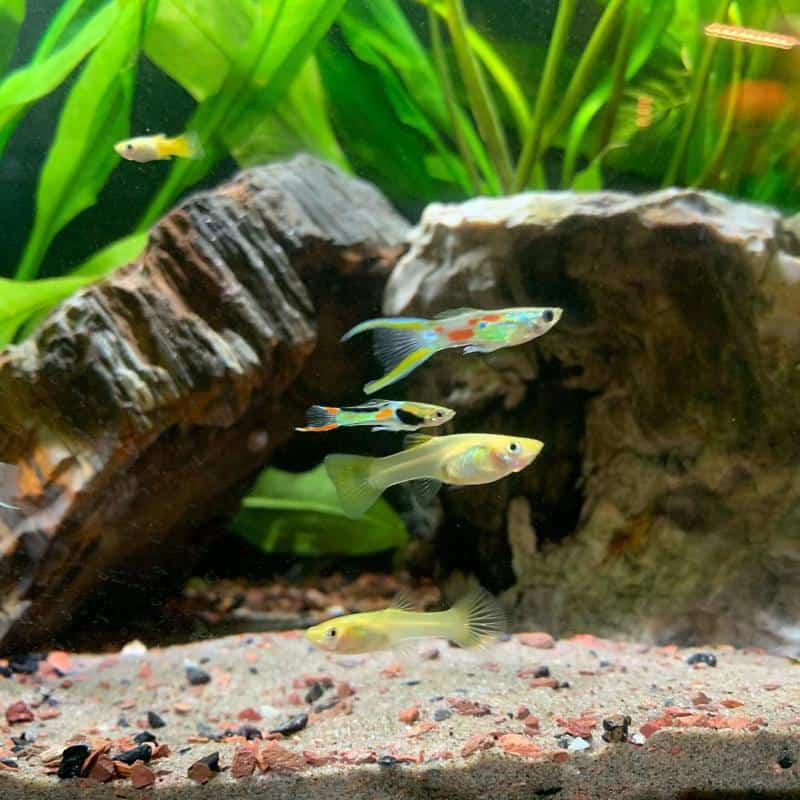
The average lifespan of Endler’s Livebearers typically ranges from 2 to 3 years in a well-maintained aquarium.
If you want your precious Endlers to live longer, you must provide them with proper care, a healthy diet, and a suitable environment. Some species have lived up to 4 or 5 years with this care.
Endler’s Livebearer Temperament and Behavior
Endler’s Livebearers are generally non-aggressive fish, making them a great choice for community fish tanks.
Still, it’s important to consider the tank size and compatibility when selecting tankmates for Endler’s Livebearers. Due to their size, they can become targets for larger or more aggressive fish. It’s best to avoid keeping them with species that may harass or prey on them.
Additionally, it’s worth noting that male Endlers’ livebearers can sometimes display territorial behavior among themselves, particularly when multiple males are present in the same tank.
Providing lots of hiding spots, plants, and adequate swimming space can help alleviate potential territorial disputes.
Endler’s Livebearer Tank Size
The recommended tank size for Endler’s Livebearers depends on how many of them you’d like to keep.
The minimum we recommend, however, is 10 gallons because you’ll need at least 6 of them to keep them happy.
You may be able to get away with 3 Endlers in a 5-gallon tank as long as you’re willing to keep a close eye on them. Additionally, this should be a single-sex tank, as you don’t want them giving birth and overcrowding your aquarium.
Of course, the more fish you plan to keep, the larger your tank needs. In fact, if you want to keep both male and female Endlers together, you should get at least a 20-gallon to give space for new offspring.
How Many Endler’s Livebearers per Gallon
The recommended stocking density for Endler’s Livebearers is typically around 1 fish per 1.5 gallons of water. Endlers are endlessly active and require a wide swimming space, especially during their breeding season.
Endler’s Livebearer Tank Setup
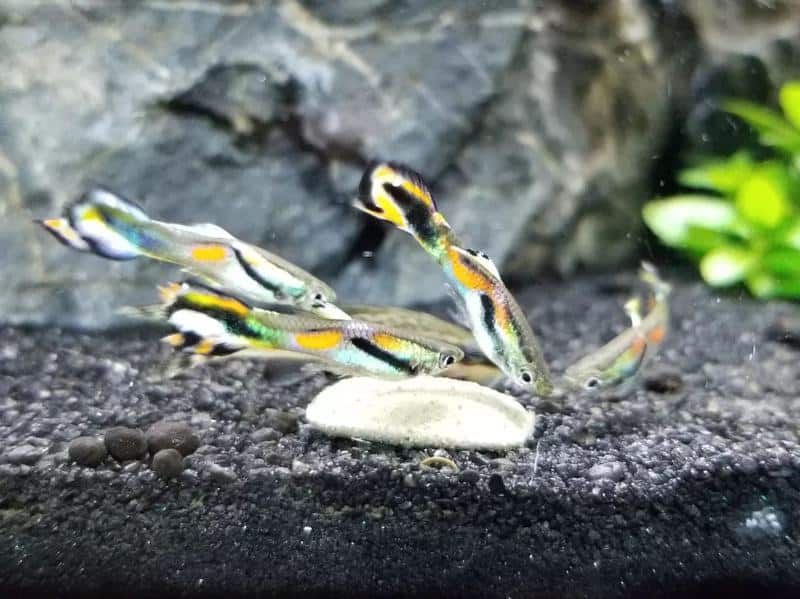
Creating an ideal tank setup for Endler’s Livebearers involves providing suitable decorations and a well-balanced environment. Here’s how you can get started on your Endler’s Livebearer tank setup.
- Use a fine-grained substrate like sand or fine gravel, as Endler’s Livebearers often like to sift through the substrate while foraging.
- Plants and Cover. Live plants and structures in the aquarium are also highly preferable. For plants, choose hardy species such as Java moss, Java fern, and Amazon sword that can withstand the water parameters that these species love. They’re not as picky with driftwood and rocks as long as it provides cover.
- Because of their small size, a sponge filter or a gentle-flow hang-on-back filter is for Endler’s Livebearers. Still, they can tolerate higher water flow than most other fishes their size.
Don’t forget to acclimate new fish properly and maintain regular water changes to keep the tank clean and the water parameters stable.
Endler’s Livebearer Temperature
The ideal temperature range for your Endler’s Livebearer is 75 to 86°F or 24 to 30°C. Keep in mind that this species is used to more sun and higher temperatures than their other live-bearing cousins, so a heater is necessary if you live in a cold-weather area.
Endler’s Livebearer Water Parameters
Although Endlers can survive on a wide range of water parameters, they still have a preferred environment where they thrive best.
- pH Level. Aim for a slightly acidic to neutral pH level of 6.5-7.5, closest to this species’ natural habitat.
- Water Hardness. Keep the water hardness (GH) in the range of 5-15 dGH (degrees of General Hardness), as this range provides the necessary minerals and nutrients.
- Ammonia and Nitrite. Ensure that ammonia and nitrite levels are consistently at zero. Both ammonia and nitrite are highly toxic to fish and can cause severe health issues.
- Nitrate Levels. Keep nitrate levels below 20-30 ppm (parts per million). Endlers can somewhat tolerate higher nitrate levels, but it’s still best to keep them as low as possible to prevent potential health problems.
It’s important to note that stability is key regarding water parameters. Sudden fluctuations or drastic temperature, pH, or water hardness changes can stress the fish and make them sick.
Use API’s Freshwater Master Test Kit to check the water quality regularly and make sure that everything’s within the correct range.
Endler’s Livebearer Diet
Endler’s Livebearers are omnivorous fishes that will eat practically anything they can fit into their mouths. In their natural habitat, they’re used to eating small organisms in the water and grazing through layers of organic matter to look for food.
That said, the ideal diet for Endler’s Livebearers consists of a balanced and varied mix of foods. This is the best way to make sure that they’re getting all the nutrition, minerals, and vitamins they need.
Small and slow-sinking pellets are ideal for their regular meals as they tend to occupy the middle to bottom regions of the tank.
It’s also best to occasionally complement their diet with nutrient-rich live or frozen food. Endlers are natural hunters and will love hunting small insects and invertebrates.
Feed them twice a day at most, with what they can eat in a minute. Be careful of overfeeding these tiny fish, as overfeeding on dry food can give them digestive tract complications like constipation or impaction.
Endler’s Livebearer Tank Mates
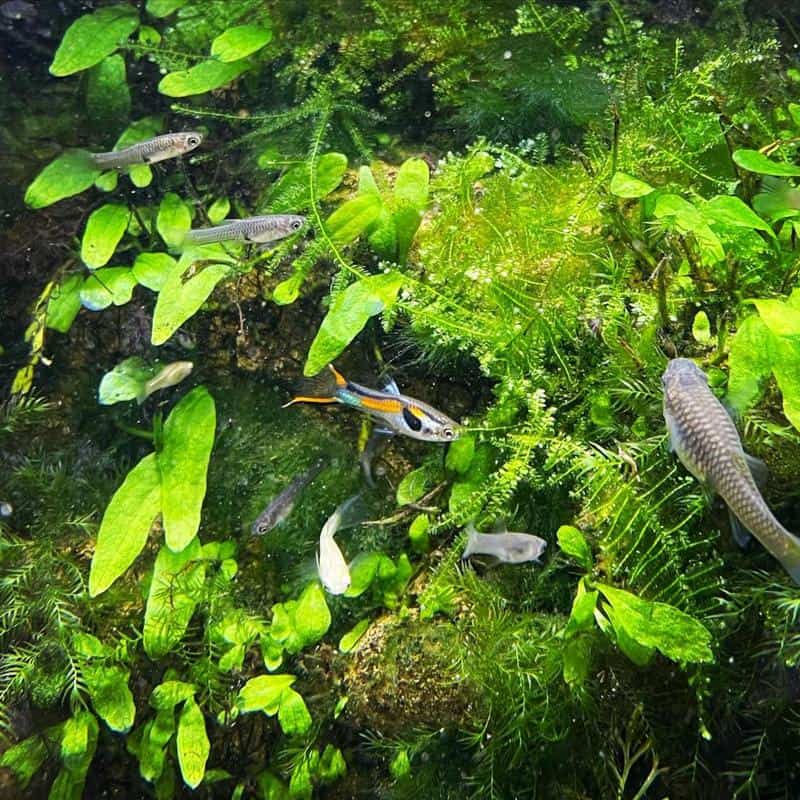
Endlers are fantastic community fish for a reason – they get along well with so many other species of fish.
- Guppies: There are no species more popular as tankmates for Endlers than Guppies. These lively and colorful fish share similar water parameter requirements, and they both give birth to live young instead of laying eggs.
- Mollies: These peaceful and hardy livebearers also have similar preferred parameters to Endlers. They add beauty and movement to the tank without posing any threat.
- Platies: Another livebearing species, platies make good tank mates with Endlers. They both love live plants and can live in the same water conditions.
- Tetras: Endlers are also compatible with Tetras, especially the smaller variants like Neons and Embers.
- Corydoras Catfish: Corydoras Catfish are bottom-dwelling fish that peacefully coexist with Endler’s Livebearers. They help keep the tank clean by scavenging for food scraps and are well-suited to the same water parameters.
- Otocinclus Catfish: Also known as “Otos,” these bottom feeders can help control algae growth and are compatible regarding water parameters and behavior.
- Shrimp: You can also house Endlers with invertebrates. They help keep the tank clean by consuming algae and detritus, adding a unique dynamic to the tank with their behavior and colors.
- Snails: Most snail species make good tank mates for Endlers. These efficient algae eaters not only contribute to the overall cleanliness of the aquarium but are also fine with most water conditions.
- Betta: In a big enough tank, Endlers can also make good tank mates for a Betta. They thrive in the same conditions and are both fond of planted tanks.
Endler’s Livebearer Common Diseases
Like any other fish, Endler’s Livebearers can be susceptible to certain diseases. Here are some common diseases that they may encounter:
- Ich: Also known as “white spot disease,” ich is a parasitic infection characterized by small white spots on the fish’s body and fins, although highly treatable.
- Fin Rot: Fin rot is a bacterial infection that affects the fins and tail of the fish. It can cause fraying, discoloration, and deterioration of the fin tissue.
- Constipation: Sometimes, Endlers can get constipated from the wrong diet and malnutrition. This can cause them to swim strangely or swim less than usual.
- Velvet: Velvet disease is a lethal parasitic infection that appears as a golden or rust-colored coating on the fish’s body. It’s highly contagious, which is dangerous for community tanks.
Prevention is key in maintaining the health of Endler’s Livebearers.
Making sure you have the proper water parameters, doing regular water changes, providing a balanced diet, and quarantining new fish before introducing them to your new tank can help minimize the risk of diseases.
Breeding Endler’s Livebearer
Breeding Endler’s Livebearers can be a very rewarding–albeit sometimes hectic–experience. Here’s a step-by-step guide on how to breed them.
- Get a partition to section your tank into two areas. Better yet, get a separate tank specifically for breeding. It should have hiding spots for the fry.
- Select healthy adult Endler’s Livebearers, maintaining a ratio of one male for every 2-3 females.
- Transfer your chosen fish to the breeding tank and allow them some time to acclimate.
- Check to see if you’re within the ideal water parameters, including temperature and pH. You can also add aquarium lights to simulate their natural habitat.
- The females should give birth within 24 days. Again, don’t forget the hiding spots for both the females and the fry.
- Once the baby fry has come out, transfer the adult fish to their main tank.
- The fry’s mouths are too small for regular fish food. Feed them crushed flakes or powdered food and monitor their growth.
Breeding Endler’s Livebearers requires patience and careful observation. With the right conditions and proper care, you can enjoy the fascinating process of watching these beautiful fish reproduce.
Read More:
FAQs
Can Endler’s Livebearers Breed with Normal Guppies?
Endler’s Livebearers can crossbreed with guppies. The crossbred fishes are called Class K Endlers. There are different popular strains of Class K Endlers, such as the Tiger Endler, Three Spots Endler, and more.
Are Endler’s Livebearers Hardier than Guppies?
Endler’s Livebearers naturally reside in pretty extreme environments for a livebearer, although which one is “hardier” can be difficult to assess.
They have different physical origins, and their ideal parameters may vary. However, both species naturally thrive in a wide range of water parameters.
Conclusion
Endler’s livebearers are amazing creatures that will add a unique appeal to your aquarium. Their vibrant colors and endlessly fascinating patterns are a joy to behold, and their hardy physiques make them easy for even beginner aquarium keepers to keep them.
In this guide, we discussed everything you needed to know about the Endler’s Livebearer, such as their ideal tank parameters, diet, and overall care.
Now, you’re equipped with all the knowledge you need to care for this wonderful fish species!
